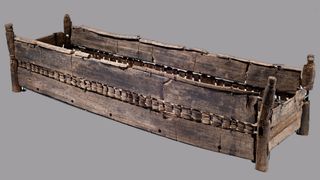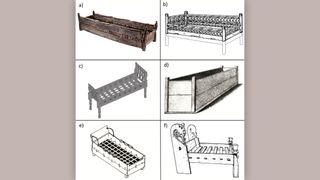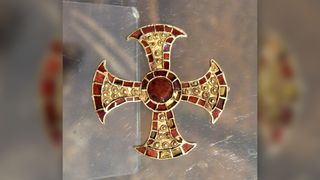Mystery behind medieval 'bed burials' in UK possibly solved
The burial rite is tied to the expansion of Christianity.

On rare occasions in medieval mainland Europe, the cream of the crop — those who were wealthy or noble — were sometimes buried as if they were going to sleep, interred on their beds in what is known as a bed burial. However, it was unclear how this practice spread to England. Now, new research reveals that bed burials gained traction in the seventh century A.D. along with the spread of Christianity and soon became a common burial rite for women.
After analyzing 72 bed burials across Europe, ranging from Slovakia to England, a researcher found that England's bed burials held only female remains. She concluded that the funerary practice in Europe occurred at a time when women were moving around more as Christian wives married non-Christian husbands, according to a new study published online June 13 in the journal Medieval Archeology.
"Bed burials were something that was specifically imported by women who were moving around at that very specific point in time [across Europe]," said Emma Brownlee, the study's sole author and a research fellow in archaeology at Girton College and a fellow at the McDonald Institute for Archaeological Research, both of which are within the University of Cambridge in England. "As part of this conversion movement, men were moving, but not at the same extent as women, who were bringing these burial rites with them as they migrated [as missionaries], causing it to take on these associations of femininity and Christianity in England."

For context, Brownlee points to the fall of the Western Roman Empire in A.D. 476, which led to Christianity to at first diminish and then thrive again in Europe.
Related: 2,100-year-old burial of woman lying in bronze 'mermaid bed' unearthed in Greece
"At this point, Christianity [had vanished] as a religion," Brownlee told Live Science. "But in the seventh century, there's this push by the church on the continent to start reaching out and converting places that aren't Christian. Pope Gregory I pushes this idea of conversion and missionaries. One of the slightly less obvious ways that the church tried to convert people was by encouraging marriages between Christian women and non-Christian men."
She added, "So, you have this specific policy of Christian families trying to marry their daughters into the English elite, who were non-Christian at the time. The idea was that the wives acted as this converting influence on the families, and so women had this really key role to play through those marriages."
Sign up for the Live Science daily newsletter now
Get the world’s most fascinating discoveries delivered straight to your inbox.
Brownlee mentioned one bed burial in particular as a point of reference: the Trumpington Bed Burial, which archaeologists excavated in 2011 in Trumpington, a village in eastern England. Like other burials in the study, it dates to the seventh century and contains the remains of a young woman buried in a wooden bed affixed with iron brackets. The burial also contained several notable grave goods, including a knife, glass beads and an ornate gold cross studded with garnets. While not much is known about the woman's identity, the cross suggests that she was most likely Christian.

According to her paper, the earliest known bed burial occurred in Eastern Europe in the fifth century A.D., and the practice spread across mainland Europe during the sixth and seventh centuries as a rite for men, women and children, including the burial of a 6-year-old boy beneath Cologne Cathedral in Germany. It wasn't until later that the burials became more common for women in seventh-century England, Brownlee said.
An analysis of isotopes, or elements with varying numbers of neutrons in their nuclei, from three of the bed burials in England revealed that the women interred there didn't grow up in Britain, the study found. This chemical evidence, along with the fact that only women received bed burials in England, "suggests that it was imported by a specific group of women, likely linked to conversion efforts in the seventh century," Brownlee said in a statement. "Bed burial therefore acquired feminine and Christian characteristics in England that it did not have elsewhere."
Then why exactly were beds used as burial vessels as opposed to coffins? Brownlee thinks it could be related to a person's status, as well as a poetic metaphor regarding death.
"Not many people would've had their own bed frames back then," she told Live Science. "The ability to construct this wooden bed frame took quite a lot of labor, so it's not something that everyone could afford. Most people would've just slept on straw mattresses, but if you were important enough to have your own bed frame, that was quite a special thing."
The idea of equating death with eternal sleep may have also played a role.
"There might also be connotations of sleep going along with it," Brownlee said. "So it's telling us a little bit about how people were relating to death, and they saw it as if they're going to sleep rather than it being some final end."
The remains of the Trumpington Bed Burial are currently on display at the Museum of Archeology and Anthropology at the University of Cambridge in England.
Originally published on Live Science.

Jennifer Nalewicki is a Salt Lake City-based journalist whose work has been featured in The New York Times, Smithsonian Magazine, Scientific American, Popular Mechanics and more. She covers several science topics from planet Earth to paleontology and archaeology to health and culture. Prior to freelancing, Jennifer held an Editor role at Time Inc. Jennifer has a bachelor's degree in Journalism from The University of Texas at Austin.
Most Popular

